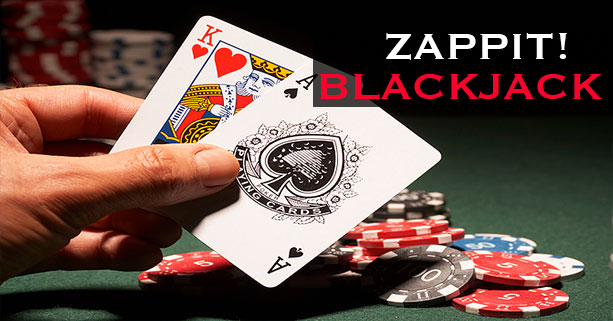Geoff Hall must enjoy blackjack games which start with the letter “Z.” He’s not only the mastermind who created Zombie Blackjack, he’s also the inventor of Zappit.
The idea behind Zappit is that you can choose to zap a hand and get a new hand. The only hands you can do this with are the worst hands in the game, the 15, 16, 17, and (in some casino), the 18. Since those are the hands that are likely to bust if you hit them but likely to lose if you stand, it’s pretty exciting to be able to just ditch that total and get a do-over.
Of course, anytime someone designs a new blackjack variation, they come up with a rule or multiple rules to compensate for the change. Geoff Hall is a big fan of the “push 22” rule, which he uses in multiple games. That works by treating a dealer’s total of 22 as a push instead of a win.
How to Play Zappit – Complete Rules
Zappit is a blackjack game, so the basic rules are the same as for any other blackjack game. You get 2 cards, and so does the dealer. The cards are worth between 1 and 11 each—the numbered cards are worth their number, while face cards are worth 10 points each. Aces can count as 1 or 11, whichever is better for your hand.
The dealer gets her cards after the players, and one of her cards is always face up. The other is always face down. You make your playing decisions based on your totals AND what the dealer is showing. The most basic decisions are to hit or to stand. If you hit, the dealer gives you an additional card, and your total increases by that card’s value. If you stand, you just stick with the total you have.
The more complicated decisions are splitting and doubling down. Splitting is something you can do if you have 2 cards of the same rank. You split by putting up an additional bet and starting 2 new hands. The first card of each of those 2 hands comes from your original hand.
When you do, you get a brand-new 2-card hand. If you get a blackjack after zapping your original hand, you win immediately, but you only get even money. (Blackjacks normally pay off at 3 to 2. A blackjack is a 2-card hand that totals 21.)
The dealer in Zappit must play her hand in a prescribed way. If she has a total of 16 or less, she must hit. She also hits a soft total of 17. (A soft total is a hand that includes an ace—since the ace can count as 1 instead of 11, the total is “soft” instead of “hard.”) If you split aces, you only get one card. You can’t hit after that or double down. With other cards you split, you can double down after splitting and hit as many times as you like.
Zappit Blackjack Strategy, House Edge, and Review
I like how simple Zappit is in terms of rules changes. There are basically only 2 differences between this game and standard blackjack:
- You can zap a hand if you have a stiff total. (That’s a fancy name for a total of 15, 16, or 17.) This rule, obviously, benefits the player.
- The dealer pushes if he has a 22. This rule, of course, benefits the casino, since this is a total where the dealer would normally lose.
The house edge for this variations of blackjack is between 1.1% and 1.3%. Since many blackjack games offer a house edge of 0.5% or less than 1%, this is inferior to the standard game. But it provides you with an interesting rules variations, so that might be worth giving up 0.5% or so in expected return. I’ll leave that to you to decide. In terms of strategy, the 1st thing you’ll need to consider is whether to zap your total (if you’re able to.)
Luckily, that decision is pretty easy:
You’ll always zap a hard 15, 16, or 17, no matter what card the dealer is showing. If you have a pair of 8s, though, you’ll split if the dealer has a 6 or 7 showing.
In a casino that allows you to zap a total of 18, you’ll stand if the dealer shows an 8 or less. Otherwise, you’ll zap it. If you have a pair of 9s, though, you’ll split if the dealer has a 4, 5, 6, or 8. You’ll stand if the dealer has a 7 showing, or if the dealer has a 2 or 3 showing. Otherwise, you’ll zap it. Once you’ve made this decision, you just play the rest of your hand using normal basic strategy.
I’ve covered basic strategy in other posts on this site, but in brief, here’s what that means:
Most people learn basic strategy by memorizing some kind of colored chart or table that compares your total with the dealer’s up-card. I tend to prefer an approach where you memorize certain rules for how to play your hands based on text. Different learning styles and different approaches are fine, though.
Conclusion
You can find Zappit online at Bodog and Bovada casinos, but it’s also available at multiple land-based casinos. It’s a fun blackjack variant, even though the house edge for the game is none too impressive. That being said, it’s a better deal than many blackjack variants. In fact, some blackjack variations pale in comparison to Zappit.
And unlike some other variants of blackjack, you can actually play this one online. Some newer games aren’t available at online casinos at all. This makes Zappit a refreshing change of pace all by itself.

 MENU
MENU











